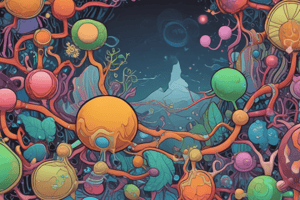Podcast
Questions and Answers
What is the primary synthesis location of Apolipoprotein A-V?
What is the primary synthesis location of Apolipoprotein A-V?
- Adipose tissue
- Liver (correct)
- Intestine
- Muscle
Which apolipoprotein is specifically associated with the structural composition of chylomicrons?
Which apolipoprotein is specifically associated with the structural composition of chylomicrons?
- Apo A-IV
- Apo B-48 (correct)
- Apo C-II
- Apo E
Apolipoproteins C-II and C-III have opposing roles. What function does Apo C-II serve?
Apolipoproteins C-II and C-III have opposing roles. What function does Apo C-II serve?
- Enhances receptor interaction of triglyceride rich lipoproteins
- Increases atherosclerosis risk
- Stimulates triglyceride hydrolysis (correct)
- Inhibits lipoprotein lipase activity
What is a key risk factor associated with high levels of Apo B-100?
What is a key risk factor associated with high levels of Apo B-100?
Which apolipoprotein serves as a co-factor for lipoprotein lipase (LPL)?
Which apolipoprotein serves as a co-factor for lipoprotein lipase (LPL)?
Which apolipoprotein is known to inhibit fibrinolysis?
Which apolipoprotein is known to inhibit fibrinolysis?
Apolipoprotein E primarily aids in the metabolism of which lipoproteins?
Apolipoprotein E primarily aids in the metabolism of which lipoproteins?
What role does Apo C-III play in lipid metabolism?
What role does Apo C-III play in lipid metabolism?
Who studied the process of fatty acid synthesis and won the Nobel prize in 1964?
Who studied the process of fatty acid synthesis and won the Nobel prize in 1964?
Where does the de novo synthesis of fatty acids primarily occur?
Where does the de novo synthesis of fatty acids primarily occur?
Which fatty acid is primarily synthesized through the de novo pathway?
Which fatty acid is primarily synthesized through the de novo pathway?
Which of the following is included in the net reaction for the de novo synthesis of palmitate?
Which of the following is included in the net reaction for the de novo synthesis of palmitate?
What is the primary function of chylomicrons in lipid metabolism?
What is the primary function of chylomicrons in lipid metabolism?
Which class of lipoproteins is characterized as the largest and least dense?
Which class of lipoproteins is characterized as the largest and least dense?
How are plasma lipoproteins primarily classified?
How are plasma lipoproteins primarily classified?
What happens to the size of chylomicrons in the fasting state compared to after a high-fat meal?
What happens to the size of chylomicrons in the fasting state compared to after a high-fat meal?
What happens to chylomicrons after triglyceride is removed by lipoprotein lipase?
What happens to chylomicrons after triglyceride is removed by lipoprotein lipase?
Which lipoprotein is primarily responsible for carrying the majority of cholesterol in circulation?
Which lipoprotein is primarily responsible for carrying the majority of cholesterol in circulation?
Which type of apolipoprotein accounts for approximately 70% of HDL protein?
Which type of apolipoprotein accounts for approximately 70% of HDL protein?
What is one of the significant roles of HDL particles in the body?
What is one of the significant roles of HDL particles in the body?
How do IDL particles differ from VLDL particles?
How do IDL particles differ from VLDL particles?
What is the relationship between apolipoprotein A-II and cardiovascular disease (CVD)?
What is the relationship between apolipoprotein A-II and cardiovascular disease (CVD)?
Which lipoprotein type is primarily triglyceride-rich and produced by the liver?
Which lipoprotein type is primarily triglyceride-rich and produced by the liver?
What is one of the functions of apolipoproteins?
What is one of the functions of apolipoproteins?
Flashcards
De Novo Fatty Acid Synthesis
De Novo Fatty Acid Synthesis
The process of synthesizing fatty acids from smaller molecules like acetyl-CoA. It primarily occurs in the cytoplasm of cells, specifically in tissues like the liver, adipose tissue, and mammary glands.
Palmitic Acid
Palmitic Acid
A 16-carbon saturated fatty acid, the primary product of de novo fatty acid synthesis.
Fatty Acid Synthase
Fatty Acid Synthase
The enzyme complex responsible for catalyzing the de novo synthesis of fatty acids, operating mainly in the cytoplasm.
Lipoproteins
Lipoproteins
Signup and view all the flashcards
Chylomicrons
Chylomicrons
Signup and view all the flashcards
Very Low-Density Lipoprotein (VLDL)
Very Low-Density Lipoprotein (VLDL)
Signup and view all the flashcards
Low-Density Lipoprotein (LDL)
Low-Density Lipoprotein (LDL)
Signup and view all the flashcards
High-Density Lipoprotein (HDL)
High-Density Lipoprotein (HDL)
Signup and view all the flashcards
Apolipoprotein
Apolipoprotein
Signup and view all the flashcards
Apo A-IV
Apo A-IV
Signup and view all the flashcards
Lipoprotein Lipase (LPL)
Lipoprotein Lipase (LPL)
Signup and view all the flashcards
Apo A-V
Apo A-V
Signup and view all the flashcards
Apo B-48
Apo B-48
Signup and view all the flashcards
Apo B-100
Apo B-100
Signup and view all the flashcards
Apo C
Apo C
Signup and view all the flashcards
What are chylomicron remnants?
What are chylomicron remnants?
Signup and view all the flashcards
What is VLDL, and how does it relate to chylomicrons?
What is VLDL, and how does it relate to chylomicrons?
Signup and view all the flashcards
What are IDL particles, and how are they formed?
What are IDL particles, and how are they formed?
Signup and view all the flashcards
What is LDL, and what role does it play in cholesterol transport?
What is LDL, and what role does it play in cholesterol transport?
Signup and view all the flashcards
What is HDL, and what makes it different from other lipoproteins?
What is HDL, and what makes it different from other lipoproteins?
Signup and view all the flashcards
What are the functions of apolipoproteins?
What are the functions of apolipoproteins?
Signup and view all the flashcards
What is Apo A-I, where is it made, and what does it do?
What is Apo A-I, where is it made, and what does it do?
Signup and view all the flashcards
What is Apo A-II, and what effect does it have on cardiovascular risk?
What is Apo A-II, and what effect does it have on cardiovascular risk?
Signup and view all the flashcards
Study Notes
De Novo Synthesis of Fatty Acids
- Fatty acid synthesis was studied by Feodor Lynen, who received the Nobel Prize in 1964.
- The pathway is also referred to as Lynen's spiral.
- Fatty acids are primarily synthesized in the cytoplasm.
- The major fatty acid synthesized de novo is palmitic acid (16 carbons).
- This process occurs in liver, adipose tissue, kidney, brain, and mammary glands.
- The net reaction of de novo fatty acid synthesis can be summarized as: 1Acetyl CoA + 7Malonyl CoA + 14NADPH + 14H → 1Palmitate + 7CO2 + 14NADP + 8CoA + 6H₂O.
- Note: fatty acid synthesis is not an exact reversal of beta-oxidation.
Lipoproteins
- Lipoproteins are complex particles composed of a hydrophobic core of non-polar lipids (primarily triglycerides and cholesterol esters) surrounded by a hydrophilic membrane (phospholipids, free cholesterol, and apolipoproteins).
- Plasma lipoproteins are classified into seven types based on size, lipid composition, and apolipoproteins.
Classes of Lipoproteins
- Chylomicrons: Largest and least dense lipoproteins, transporting dietary triglycerides and cholesterol. Size varies with fat intake. Small particles in the fasting state.
- Chylomicron remnants: Smaller particles formed when peripheral tissues remove triglycerides from chylomicrons via lipoprotein lipase. Enriched in cholesterol, pro-atherogenic.
- Very Low-Density Lipoproteins (VLDL): Liver-produced; rich in triglycerides. Large particles when triglyceride production is high, smaller than chylomicrons.
- Intermediate-Density Lipoproteins (IDL): formed from VLDL; enriched in cholesterol; pro-atherogenic.
- Low-Density Lipoproteins (LDL): Formed from VLDL and IDL; very rich in cholesterol; major cholesterol carrier in circulation.
- High-Density Lipoproteins (HDL): Play a role in reverse cholesterol transport (from peripheral tissues to liver). Anti-oxidant, anti-inflammatory, anti-thrombotic, and anti-apoptotic properties. Associated with decreased risk of atherosclerosis; enriched in cholesterol and phospholipids.
- Lipoprotein (a) (Lp(a)): Homolog of plasminogen; high levels are associated with an increased risk of atherosclerosis.
Apolipoproteins
- Apolipoproteins have four major functions: structural role, ligands for receptors, regulating lipoprotein formation, and activating/inhibiting enzymes involved in lipoprotein metabolism.
- Various types of apolipoproteins exist: A-I, A-II, A-IV, A-V, B-48, B-100, C (C-I, C-II, C-III), and E. Each has specific roles in lipoprotein metabolism.
- Apo A-I is the major structural protein in HDL, associated with a decreased risk of atherosclerosis.
- Apo B-100 is a major structural component of VLDL, IDL, and LDL, associated with increased risk of atherosclerosis.
- Apo C-II acts as a co-factor for lipoprotein lipase (LPL), stimulating triglyceride hydrolysis.
- Apo C-III inhibits LPL and interactions of triglyceride-rich lipoproteins with their receptors.
- Apo E associated with chylomicrons, chylomicron remnants, VLDL, IDL, and HDL.
- Apo (a) is a homolog of plasminogen and high levels are associated with increased risk of atherosclerosis.
Studying That Suits You
Use AI to generate personalized quizzes and flashcards to suit your learning preferences.
Related Documents
Description
This quiz explores two key concepts in biochemistry: de novo synthesis of fatty acids and the structure of lipoproteins. Learn about the pathway described by Nobel Laureate Feodor Lynen, along with the classification and composition of various lipoproteins. Test your knowledge with this comprehensive overview.




